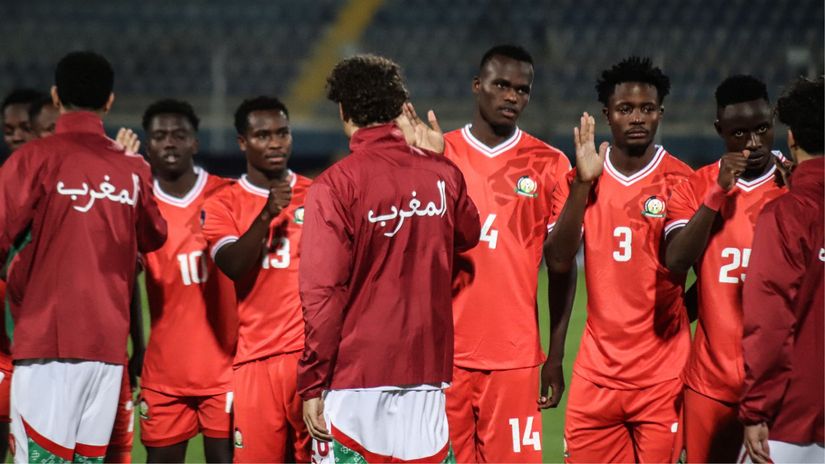Kenya’s historic participation in the CAF U-20 Africa Cup of Nations (AFCON) came to an end after the Rising Stars failed to progress beyond the group stage.The Rising Stars qualified for the 2025 U-20 AFCON as one of two representatives from the CECAFA region. This marked not only their debut in the tournament but also the first time a Kenyan youth football team had qualified for a continental competition.##NAJAVA_MECA_8916697##Follow our WhatsApp channel for more newsKenya finished bottom of Group B—a group described as the “Group of Death” prior to the tournament—after suffering two defeats and securing one draw.A narrow 3-2 loss to group leaders Morocco, a 3-1 defeat at the hands of Tunisia, and a 2-2 draw with Nigeria summed up the Rising Stars’ AFCON campaign.Mozzart Sport highlights six key lessons from Kenya’s AFCON journey:Simbine hails “big name” Ferdinand Omanyala for rise of sprinting in Africa1. Defensive mistakes cost KenyaThe defensive frailties in the Rising Stars’ squad were both visible and costly.Nearly all the goals Kenya conceded were preventable, and eliminating those errors could have guaranteed a spot in the quarter-finals.In each of the three matches, Kenya took the lead but failed to hold onto it due to a poor defensive setup and individual lapses.From failing to clear the ball when necessary, defending casually, lacking discipline, and going soft into tackles to being easily drawn into conceding fouls—Kenya got it all wrong at the back.In tournaments like AFCON, titles are often won by solid defenses. Kenya’s ability to score was undermined by its inability to defend.Simbine hails “big name” Ferdinand Omanyala for rise of sprinting in Africa2. Goalkeeping concernsWhile the defense struggled, the goalkeeping department also left much to be desired.In the first match, Kariobangi Sharks’ Bernard Jairo played the full 90 minutes but picked up an injury that ruled him out of the remaining games. He was replaced by Bidco United’s Wycliford Oduor for the final two matches.However, in all three games, the goalkeeping looked shaky, with poor communication and coordination with the defensive line.Despite both keepers having FKF Premier League experience, they appeared out of depth and unable to organize their defenses effectively.This was a stark contrast to the team’s solid performances in the qualifiers and earlier tournaments, where Kakamega Homeboyz’s Ibrahim Wanzala was the first-choice keeper.Wanzala’s omission from the AFCON squad was a major talking point—and in hindsight, proved to be a mistake.FKFPL: Kenya Police seek to extend lead at the top as KCB fight for pride against Shabana3. Conceding penalties: A Kenyan problemIf you thought conceding penalties was a problem limited to Harambee Stars, think again—it appears to be a national issue.Kenya conceded a penalty in all three of their group matches, mostly due to lapses in concentration and poor decision-making in the box.A similar scenario unfolded with the Kenya U-17 girls’ elimination by Cameroon in the 2025 FIFA U-17 Women’s World Cup qualifiers, as well as in recent senior team performances.This persistent issue across Kenyan national teams needs urgent addressing.4. Absence of a defensive midfielderOne glaring issue throughout the tournament was the lack of a natural defensive midfielder.Sweden-based Stanley Wilson was absent, and coach Antony Akhulia opted to use Kevin Wangaya—a natural central or attacking midfielder—in a holding role.While Wangaya gave his best, the position required someone more suited to the role to provide adequate defensive cover and dictate play.As a result, Kenya not only lacked solidity in midfield but also missed Wangaya’s offensive contributions, which had been crucial in the qualifiers.Wilson’s absence, coupled with the lack of a proper replacement, hurt Kenya’s chances. In the final match, Irad Mshindi was deployed in a defensive role, allowing Wangaya to move forward more effectively.STARS ABROAD: Vyner’s English Premier League hopes dimmed as Tegisi scores in Tanzania5. Lack of experienceKenya’s struggles to control matches, defend effectively, and convert chances pointed to one issue—lack of experience.While Kenya faced teams with Europe-based players and others from top African leagues, they failed to make the most of their own experienced players.The decision to drop seasoned talents like Austin Odongo, Gilbert Abala, Ibrahim Wanzala, and Henry Omollo from the squad raised eyebrows. Meanwhile, limited playing time was given to the likes of Kelly Madada and Humphrey Aroko.Players who are accustomed to high-pressure environments could have made a difference on such a big stage.6. Standout performances: Kevin Wangaya and Manzur OkwaroDespite the many disappointing aspects of Kenya’s campaign, there were some bright spots—namely Kevin Wangaya and Manzur Okwaro.Even when played out of position, Wangaya showed great work ethic and determination to influence the game from midfield.In the final group match, when restored to his preferred role, the former Kariobangi Sharks man delivered a man-of-the-match performance.Defensively, while Captain Amos Wanjala struggled with form and errors, KCB’s Manzur Okwaro stood out. He worked tirelessly to cover for the goalkeeper and even performed admirably when shifted to left back.Mihic urges fans to keep peace as Mashemeji Derby returns to Kasarani

